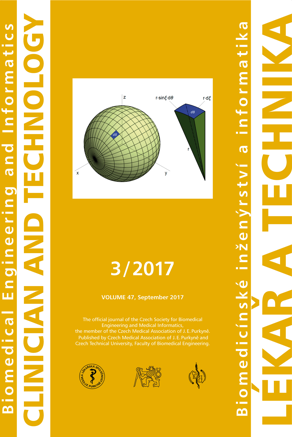RELIABILITY AND SOURCE OF ERRORS IN END-TIDAL GAS CONCENTRATION EVALUATION ALGORITHMS DURING AVALANCHE SNOW AND REBREATHING EXPERIMENTS
Keywords:
hypercapnia, EtCO2, avalanche, snow burial, device error, Datex S/5, CARESCAPE B650Abstract
During breathing experiments in avalanche snow, measurement of CO2 is often conducted in order to monitor the volunteers or as an endpoint of the trials. From the measured CO2 curves, monitors calculate end-tidal CO2 concentrations (EtCO2). The aim of the study is to investigate, whether Datex-Ohmeda S/5 anesthesia monitor evaluates EtCO2 and other parameters of breathing gas correctly, otherwise to characterize the occurrence of the error and to find out a possible cause of error. Data from a real experiment aimed at investigation of work of breathing into snow in the presence and absence of an artificial air pocket were used to study precision of the monitor. The data were evaluated in Matlab environment. The analysis found that the average error of EtCO2 evaluation occurred in 39% and in 30 % of the total experimental time of breathing with and without the air pocket respectively (range from 13% to 93% of time). Breathing experiments with simulated snow were conducted in order to find the cause of the error. The error occurs immediately after a significant increase of CO2 in the breathing circuit as a consequence of expired gas rebreathing and is independent on other breathing parameters related to a change in breathing pattern. The experiment confirmed that a newer model CARESCAPE B650 monitor is prone to this error as well. The last experiment conducted with a standard anesthesia machine but with removed CO2 absorbing soda lime confirmed, that the error occurs even in a standard clinical setup, which might cause a wrong diagnoses or might harm a volunteer or a patient.Downloads
Published
Issue
Section
License
Copyright (c) 2017 Karel Roubík, Jan Filip

This work is licensed under a Creative Commons Attribution 4.0 International License.
Authors who publish with this journal agree to the following terms:
- Authors retain copyright and grant the journal right of the first publication with the work simultaneously licensed under a Creative Commons Attribution License (https://creativecommons.org/licenses/by/4.0/) that allows others to share the work with an acknowledgment of the work's authorship and initial publication in CTJ.
- Authors are able to enter into separate, additional contractual arrangements for the non-exclusive distribution of the journal’s published version of the work (e.g., post it to an institutional repository or publish it in a book), with an acknowledgment of its initial publication in this journal.
- Authors are permitted and encouraged to post their work online (e.g., in institutional repositories or on their website or ResearchGate) prior to and during the submission process, as it can lead to productive exchanges.
CTJ requires that all of the content of the manuscript has been created by its respective authors or that permission to use a copyrighted material has been obtained by the authors before submitting the manuscript to CTJ. CTJ requires that authors have not used any copyrighted material illegally, as for example a picture from another journal or book, a photo, etc. It is the author’s responsibility to use only materials not violating the copyright law. When in doubt, CTJ may ask the authors to supply the pertinent permission or agreement about the use of a copyrighted material.
The opinions expressed in CTJ articles are those of authors and do not necessarily reflect the views of the publishers or the Czech Society for Biomedical Engineering and Medical Informatics.


